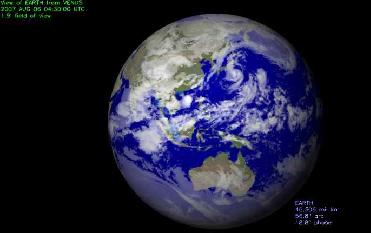
View of Earth from Venus taken by Venus Express
LONDON (BNS): It may sound bizarre since one knows that there is habitation on Earth. But, Venus Express is paving the way for a thrilling new era in astronomy, and making unprecedented contributions to mankind’s quest to find life elsewhere in universe.
Scientists said the Venus Express took its first image of the Earth with its Visible and Infrared Thermal Imaging Spectrometer (VIRTIS) immediately after its launch. David Grinspoon, a Venus Express Interdisciplinary Scientist from the Denver Museum of Nature & Science, Colorado, suggested a programme of sustained Earth observation soon after the spacecraft established itself in the orbit of Venus.
Giuseppe Piccioni, Venus Express VIRTIS Co-Principal Investigator, at IASF-INAF, Rome, Italy, said when the Earth was in a good position it was observed two or three times per month. Over the last two years, the instrument has now amassed approximately 40 images of Earth.
Scientists said that the images of Earth cover both visible and near-infrared regions of the spectrum and can be split into spectra, in order to search for the signature of molecules in the Earth’s atmosphere.
According to the European Space Agency (ESA) the value of the images lies in the fact that the Earth spans less than a pixel in Venus Express’ cameras. “In other words, it appears as a single dot with no visible surface details. This situation is something that astronomers expect to soon face in their quest for Earth-sized worlds around other stars,” the ESA said.
“We want to know what we can discern about the Earth’s habitability based on such observations. Whatever we learn about Earth, we can then apply to the study of other worlds,” Grinspoon said.
The ESA said that since 1995 astronomers have been discovering these extra solar planets and until date 300 of them have been identified. With refined observational techniques it has been possible to discover many smaller planets.
“Now, with CNES–ESA’s COROT and NASA’s Kepler missions, the prospect of discovering Earth-sized worlds in Earth-like orbits around other stars is possible,” say scientists at ESA. Grinspoon is confident: “We are now on the verge of finding Earth-like planets.”
The ESA said that with the discovery of gas giant planets, it has been proved that as soon as astronomers know that they are there, they invent all sorts of innovative methods to separate the planet’s feeble light from the overwhelming glare of the star.
By using Venus Express, scientists have confirmed that determining whether a planet is habitable is not going to be easy. “We see water and molecular oxygen in Earth’s atmosphere, but Venus also shows these signatures. So looking at these molecules is not enough,” says Piccioni.
ESA said that to substantiate the theory astronomers are going to search for more subtle signals, perhaps the so-called red edge caused by photosynthetic life. “Green plants are bright in the near infrared,” says Grinspoon, adding that the analysis to see whether this red edge is visible is just beginning.
The team will also compare spectra of the Earth’s oceans with those taken when the continents are facing Venus Express, the ESA said. “We have initiated the first sustained programme of Earth observation from a distant platform,” says Grinspoon. He said although the observations may not tell anything new about the Earth, they will allow us to unveil far-off worlds, making them seem more real than simply dots of light.














The Indian Air Force, in its flight trials evaluation report submitted before the Defence Ministry l..
view articleAn insight into the Medium Multi-Role Combat Aircraft competition...
view articleSky enthusiasts can now spot the International Space Station (ISS) commanded by Indian-American astr..
view article